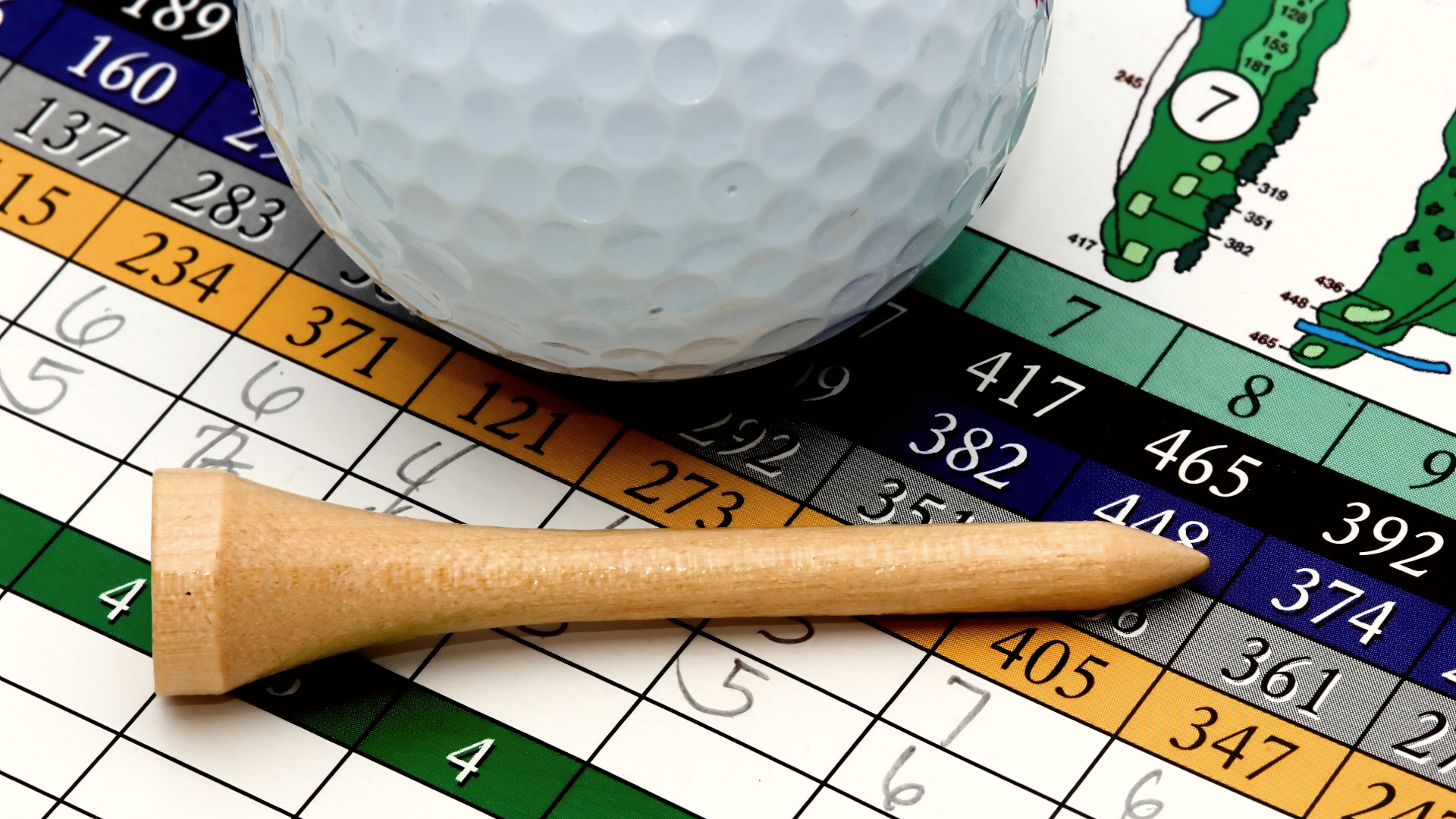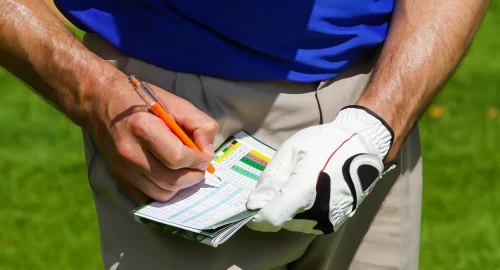
Whether you’re just picking up the game or already playing regularly, you’ve probably heard fellow golfers ask: “What’s your handicap?”
It’s one of the most common ways golfers measure performance; but if you’re not exactly sure what it means—or how it’s calculated—you’re not alone.
In this golf for beginners guide, we’ll break down exactly what a handicap is, how it’s used, and what different ranges indicate about your golf skill level. Plus, we’ll be sharing tons of strategies and training aids that can help lower your handicap fast.
What Is a Golf Handicap?
A golf handicap is a numerical representation of a golfer’s playing ability. It’s designed to level the playing field, so golfers of all skill levels can compete fairly—which is what makes golf unique compared to most other competitive sports.
Thanks to the handicap system, an everyday golfer could tee it up alongside a PGA Tour pro and still have a competitive match. That’s the power of a system that adjusts based on your ability—not just your raw score.
In simple terms: the lower your handicap, the better the golfer.
For example, a player with a 5 handicap is expected to shoot about 5 strokes over par on a typical course. A 20 handicap? Closer to 20 over par.
However, it’s important to note that your handicap is not your scoring average—it’s actually a reflection of your potential, calculated using your best rounds (more on that below).
How Is a Golf Handicap Calculated?
Today, most golfers follow the World Handicap System (WHS), which was introduced to unify handicap calculations across the globe. Here’s how it works:
- Record Your Scores: Keep track of your recent rounds, following the rules of golf. Your handicap is based on your 8 best scores from your last 20 rounds. If you haven’t played 20 yet, the system still works using fewer scores—it just adjusts accordingly.
- Adjust for Course Difficulty: Each score is adjusted using the Course Rating (difficulty for a scratch golfer) and Slope Rating (difficulty for a bogey golfer). This ensures that scores on harder courses don’t unfairly raise your handicap.
- Calculate Your Handicap Differential: For each round, a formula is used to determine your handicap differential, which accounts for score and course difficulty. Don’t worry, no math is needed on your end, the USGA Calculator takes care of it once you enter scores.
- Average the Best Differentials: Once you’ve entered enough rounds, the system averages your best 8 differentials out of the most recent 20 to create your Handicap Index. This index reflects your potential, not just your average.
- Convert to a Course Handicap: Your Handicap Index is then converted into a Course Handicap, depending on the specific course and tees you’re playing. This tells you how many strokes you’re allowed for that round, based on course difficulty.
Get started with an app like GHIN, or use the USGA site to calculate and update your handicap. Most apps let you post scores, track stats (like fairways hit, greens in regulation, etc.) and monitor trends over time.
What Do Handicap Ranges Mean?

Now that you know how a handicap is calculated, let’s look at what it actually says about your skill level. According to the USGA, the average male golfer with a registered handicap is 14.2, while the average female golfer comes in at 27.5.
Of course, factors like age, experience, and practice time all play a role—but these benchmarks are helpful if you’re just getting started and want to set realistic goals. With that in mind, let’s break down the different handicap ranges and share some strategies to help you move from one level to the next.
Beginner Golfer (25+)
- Scores are typically 100+ for 18 holes.
- Misses are frequent, but improvement comes quickly.
- Likely new to the game or still developing ballstriking fundamentals.
- Focus: Using forgiving equipment (the SF1 driver is a great option), improving contact with training aids, and learning basic swing mechanics to increase consistent muscle memory.
High Handicap (18-24)
- Scores range between 95 and 105.
- Can play a full round but struggles with consistency.
- Common issues include slicing off the tee, poor contact, and 3-putting.
- Focus: Adding distance, improving tee shots, short game fundamentals (these seven putting tips will help), and course management.
Mid-Handicap (10-17)
- Scores range from 80s to 90s.
- Still some trouble holes or inconsistency under pressure.
- Generally has a reliable tee shot and decent short game skills.
- Focus: Learning more about the mental game, sharpening iron play, wedges, and course management strategies.
Low Handicap (0-9)
- Scores in the 70s and low 80s.
- Likely has a regular practice routine and solid game plan.
- Strong all-around game with good distance control and mental focus.
- Focus: Shot shaping, scoring zone performance (100 yards and in), and consistency.
Scratch Golfer (0 or better)
- Scores in the mid 70s or better.
- Exceptional control, distance, and consistency.
- Plays in amateur events or high-level competition.
- Constantly refining small edges in every area of the game.
What’s a Good Handicap for a Beginner?
A “good” handicap for a beginner really depends on how long you’ve been playing, how often you practice, and your athletic background. But in general:
- After a few months, 28–36+ handicap is completely normal.
- After one full season, many players settle in the 22–28 range.
- After consistent play and practice, getting to the 18–20 range is a great milestone.
What matters most is that your handicap becomes a tool for measuring progress, not just performance.
How to Lower Your Handicap (Especially as a Beginner)
Lowering your handicap comes down to one thing: reducing your mistakes and improving consistency. Here are three key areas to focus on—and some helpful resources to speed up the learning curve:
1. Fix Your Slice Fast
An open clubface is one of the biggest handicap killers. It leads to weak shots, kills distance, and missed fairways. For instant help, watch this YouTube video from the Performance Golf channel.
For even more help, consider the One Shot Slice Fix from Hank Haney.
2. Dial in Your Short Game
Most beginners waste tons of strokes around the green. Focus on chipping, pitching, and distance control. These resources can help:
- Article: 5 Simple Golf Pitching Tips
- Recommended product: ONE Wedge – A versatile wedge designed to simplify short game shots and promote better contact without endless practicing.
3. Get Help
Guessing what went wrong in your swing rarely works out. If you want instant, personalized feedback, check out SwingFix AI.
Through the Performance Golf App, you can upload a video of your swing and get a custom analysis powered by artificial intelligence—plus expert coaching insights tailored to your game. It’s like having a coach in your pocket, helping you identify flaws, understand the “why” behind them, and get clear steps to improve—without overhauling your entire swing.
For even more personalized coaching, check out our VIP Coaching.
Track Your Handicap to Improve
Golf is a game of progress, not perfection. Your handicap is simply a reflection of where you are right now, not where you’ll always be. The good news? With the right focus, feedback, and tools, you can absolutely lower your handicap, whether you’re just starting out or trying to break into single digits.
Start by tracking your rounds, identifying your weaknesses, and working on one area at a time. Over time, you’ll not only lower your handicap—you’ll become a smarter, more confident golfer.

